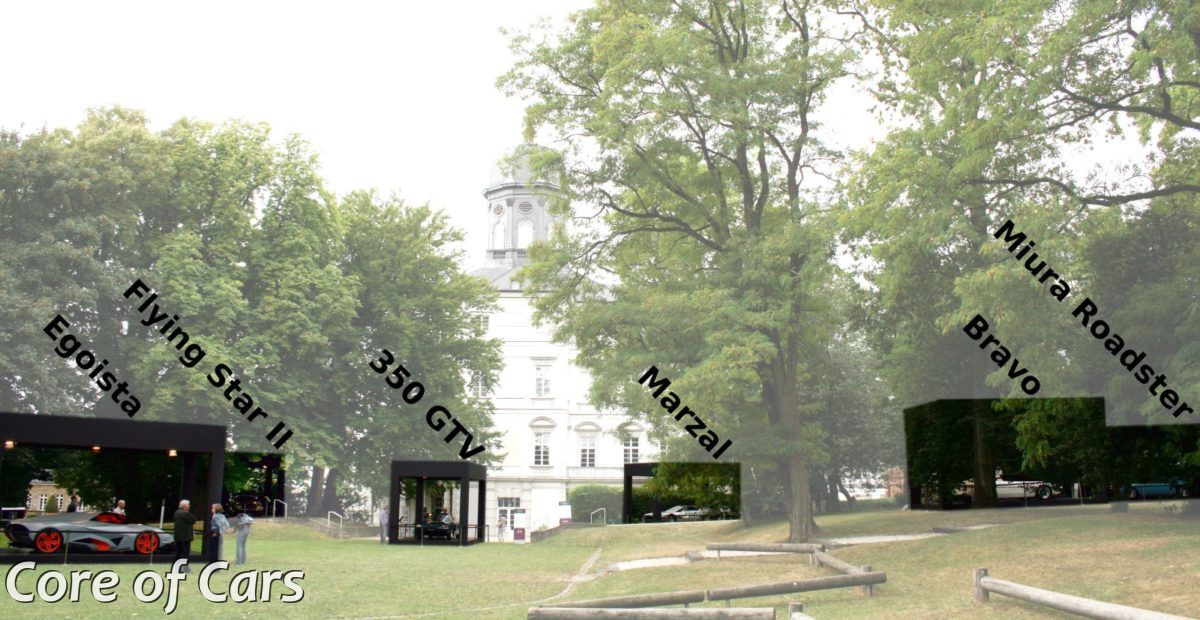I need to take you back two years, to Lamborghini’s semicentennial year. This occasion was celebrated worldwide with various takes on the theme, and the prestigious Schloss Bensberg Classics, held annually at the Bensberg Palace outside Cologne, was no exception. “50 years of Lamborghini” was one of the headlines, and after reading what they had planned for this event, I just knew I had to be there.
Early September 2013 I arrived at the palace together with three good friends, and anticipations were running high as we traversed the front yard. Behind the palace itself we arrived at a small park, with footpaths navigating the lawns and the tall trees. Scattered throughout the park were six subtle pavilions, housing the main reason for my travel: Six unique Lamborghini prototypes.
In the mind of a passionate Lamborghini enthusiast like myself, the prototypes are among the most intriguing and mythical aspects of the Lamborghini universe, and seeing just one is a major happening. Seeing six of the most significant and visually pleasing prototypes all at once is nothing less than a vision of heaven. Being by no means a professional photographer didn’t stop me from going calmly berserk with my camera, securing treasure upon treasure on my memory card. Allow me to walk you through the prototypes:
350 GTV (1963) – The very first car made by Lamborghini. Design by Franco Scaglione, the man behind the Bertone B.A.T.’s and the Alfa Romeo 33 Stradale, and V12 engine by Giotto Bizzarrini. Fell into oblivion shortly after its Turin Motor Show debut, but has since been restored and now resides in a remarkable Swiss collection.
Flying Star II (1966) – Based on the 400 GT, this car was the last creation by Touring Superleggera before they went out of business. The relatively angular shape and the unorthodox roof line yielded a mixed reception, as some found it too similar to a shooting brake. Lives in a good home in France.
Marzal (1967) – Welcomed as one of the most interesting cars from Lamborghini. Bear in mind that although the company was not yet four years old, they had already produced the 350 GT, 400 GT and Miura. Was piloted around the Monaco Grand Prix track by Prince Rainier III, Princess Grace by his side, further increasing its popularity. Only Lamborghini car ever with a straight-six engine. Stayed in the Bertone collection until it was sold at auction in 2011. Shares residence with the 350 GTV in Switzerland.
Miura Roadster (1968) – the one and only original topless Miura. Bertone made significant changes to the body and chassis to shape the Miura into a roadster. Lived many years as the ILZRO Zn75, a showcase for the International Lead and Zinc Research Organisation, who installed lots of zink-plated and chrome-plated panels and even some lead. Was restored to its original guise and now shares its address with the 350 GTV and the Marzal.
Bravo (1974) – envisioned as the perfect sibling for the Countach. Based on the Urraco, the Bravo was a novelty with its special window arrangement — the windshield appeared to curve seamlessly into the side windows, and the side windows flowed all the way into the side air intakes. Retired to the Bertone collection after clocking an impressive 70,000 kilometres during testing. Was sold alongside the Marzal at auction and went to live with the 350 GTV, Marzal and Miura Roadster.
Egoista (2013) – Designed by Walter De Silva to celebrate 50 years of Lamborghini. This extreme vehicle, inspired by jet fighters, was described by its designer as the embodiment of pure emotion and extreme hedonism. It was launched in front of more than thousand guests at the gala dinner on the eve of the last day of the 50th-anniversary celebrations. Wild interior with rear view cameras – see yours truly caught posing on the onboard screen in one of the photos. Can now be seen at the Lamborghini factory museum.
The only car I had seen before was the 350 GTV, and my expectations of seeing all of these prototypes had been off the scale prior to arriving. “Never meet your idol” was lurking in the back of my head. However, as I strolled around in the park, I found myself mesmerized by these creations: The sincerity and poise of the 350 GTV. The Flying Star II in its elegant simplicity. The Marzal, at the time, stripped down to bare metal, flaunting its shiny body and interior. The Miura Roadster sparkling with charisma. The Bravo looking outright fantastic. The tongue-in-cheek Egoista casting a spell on everyone.
One unexpected thing did annoy me, though. The bollards and barrier belts ruined a lot of photo opportunities, and it might have been better to have the barriers further away from the pavilions. I appreciate that such cars need protecting, I just wished they had found a more subtle and photo friendly way of doing so.
What a car can do to a man — a final word about the Bravo. For years, it had been one of my all time favourites from Lamborghini, and I was sincerely worried that reality would not be able to match my silver lined notion of it. To my astonishment, the Bravo was not only the most pleasant encounter of the day, but it was also plainly ravishing. Its radiant presence kept me circling its pavilion in silent admiration. The louvres, the wheels, the lines, the contours — it was all there. As I crouched down straight behind one of its rear lights, I came level with the wonderfully shaped arch that is the section between roof and side. This one moment and view alone made the entire trip worthwhile. Passion is a peculiar thing.
This article was first published on lovecars.com.

